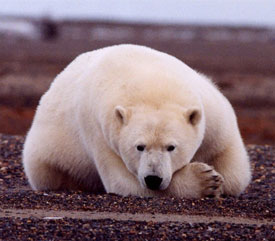Legal ruling may put endangered species at greater risk
Legal ruling may put endangered species at greater risk
Michigan Technological University
May 2, 2007
In a letter sent Monday to U.S. Secretary of the Interior Dirk Kempthorne, the Senate Committee on Environment and Public Works, and the House Committee on Natural Resources, they warn that the new definition—spelled out in a legal opinion from the Solicitor of the U.S. Department of the Interior in March—will substantially weaken the federal Endangered Species Act of 1973.
Wolves, grizzly bears and jaguars are among the species that could be hurt by the new definition, which limits endangered species to those simply “at risk of extinction.” The scientists and philosophers protesting the ruling say that the original law defined an endangered species as one “at risk of extinction throughout all or a significant portion of its range.”
“It is clear that Congress intended range’ to be the historic or former range of the animal,” said John A.Vucetich, an assistant professor of population ecology in the School of Forest Resources and Environmental Science at Michigan Technological University, Houghton, Michigan. Vucetich said. “That makes the Act restorative and very powerful, as Congress intended. The new ruling defines range as current range.’ That means the Act can’t be used to expand the existing range, even if that is necessary for the viability of a species.”
“The proposed rule would have allowed our national symbol, the bald eagle, to become extinct in the lower 48 states, surviving only in Alaska, and it would have allowed the gray whale to become extinct in U.S. waters,” Vucetich went on to say.
 Polar bear Courtesy of the U.S. Fish and Wildlife Service |
Vucetich and Michael P. Nelson, associate professor of environmental philosophy and ethics at Michigan State University, have collected 38 signatures on the letter protesting the newly restricted definition of “endangered” or “threatened” species.
It’s a stellar list, including ecological luminaries Edward O. Wilson, Pellegrino Research Professor in Entomology, Harvard University; Gus Speth, dean of Yale University’s School of Forestry and Environmental Studies; Stuart Pimm, the Doris Duke Professor of Conservation Biology at Duke University; Michael Soulé, professor emeritus of environmental studies at the University of California, Santa Cruz; Reed Noss, president of the North American Section of the Society for Conservation Biology; and Phil Hedrick, Ullman Professor of Biology at Arizona State University.
Leading environmental philosophers who signed the letter include Holmes Rolston, III, University Distinguished Professor of Environmental Ethics at Colorado State University; J. Baird Callicott, Regents’ Distinguished Professor of Environmental Ethics at the University of North Texas; and Bryan Norton, professor of environmental ethics and policy at Georgia Institute of Technology.
“The Solicitor’s ruling presents ecological, philosophical and logical problems,” explained Nelson, “The ESA is an act that codifies an ethic which asserts that species possess intrinsic value. This recent ruling attempts to undo a moral commitment made by the American people in 1973.”
“Congressional intent about the Act is clear,” said Vucetich, who recently co-authored a scholarly article with Nelson on the meaning of the words “endangered” and “recovery” in the Endangered Species Act. Their paper was published in the October 5, 2006 issue of the peer-reviewed journal, Conservation Biology. “The Act is intended to allow species to be restored throughout a large portion of their former or historic range. We object to the Solicitor’s ruling because it waters down the Act.”
Vucetich, Nelson, and the other experts who signed the letter are urging Secretary Kempthorne to “consult with the nation’s leading environmental scholars before defining terms such as endangered species.”
Earlier
-
‘Reign of terror’ over Fish and Wildlife Service ends with resignation. Julie A. MacDonald, the deputy assistant secretary at the Interior Department who riled environmentalists by seeking to gut the endangered species act, has resigned. The resignation comes a month after MacDonald was rebuked for illegally distributing internal agency documents to industry lobbyists.
This is a modified news release from Michigan Technological University.